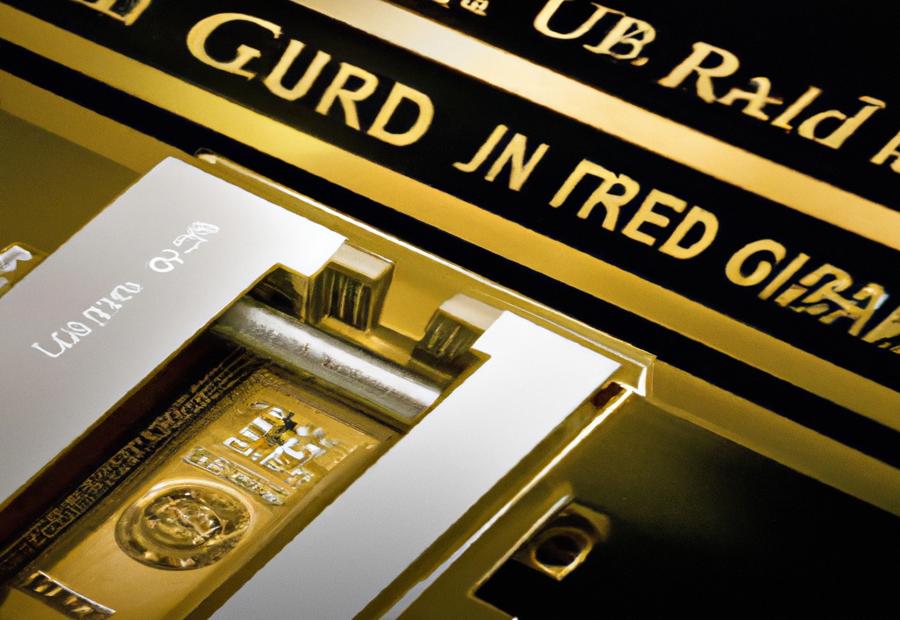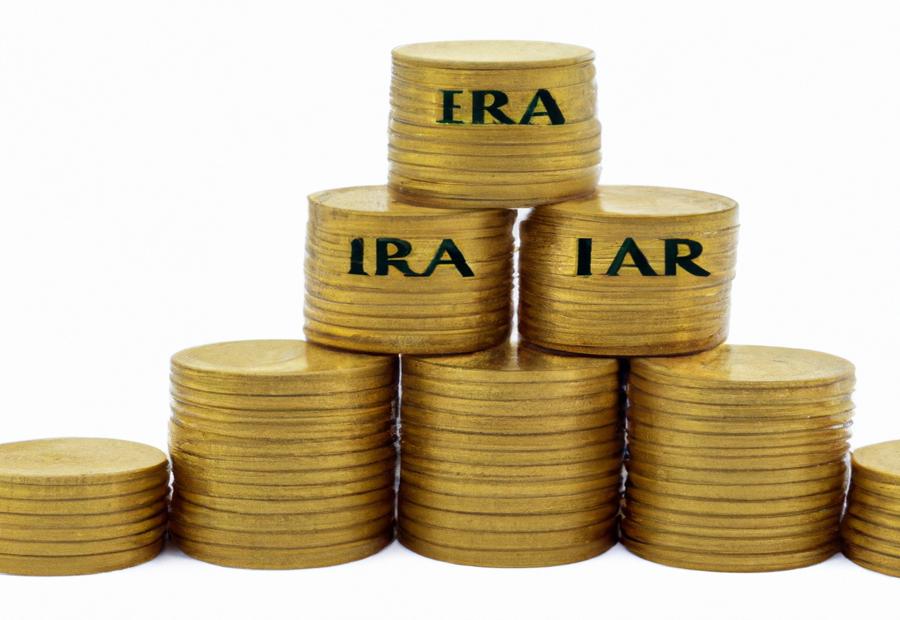Key Takeaways:
- Understanding Gold IRAs:
- A Gold IRA is a type of individual retirement account that allows investors to hold physical gold as an investment.
- There are different types of Gold IRAs, including Traditional Gold IRAs and Roth Gold IRAs.
- Investing in Gold IRAs offers benefits such as portfolio diversification and protection against inflation.
- However, there are also drawbacks to investing in Gold IRAs, such as storage and insurance costs.
- Setting Up a Gold IRA:
- Finding a reputable Gold IRA company is essential for setting up a Gold IRA.
- Selecting an IRS-approved custodian is necessary to ensure compliance with regulations.
- Purchasing approved gold is a crucial step in setting up a Gold IRA.
- Storing gold in an approved depository provides security for the investment.
- Funding a Gold IRA:
- Rolling over funds from other retirement accounts is a common way to fund a Gold IRA.
- There are contribution limits and annual funding restrictions for Gold IRAs.
- Financial advisors often recommend allocating a portion of retirement savings to Gold IRAs.
- Considerations for Gold IRA Investments:
- Investors need to be aware of IRS rules and regulations regarding Gold IRAs.
- Choosing a reputable Gold IRA company is crucial for a successful investment.
- Transparency of fees should be considered when selecting a Gold IRA company.
- Understanding the risks and potential returns is important in making informed investment decisions.
- Seeking financial planning and advice can help maximize the benefits of a Gold IRA.
- Managing a Gold IRA:
- Regularly monitoring the performance of gold investments is recommended.
- Understanding withdrawal rules and penalties is important for managing a Gold IRA.
- Tax implications of gold IRA distributions should be considered when making withdrawals.
- Following best practices and strategies can help maximize the benefits of a Gold IRA.
Understanding Gold IRAs
Photo Credits: Ecopolitology.Org by Willie Taylor
Gold IRAs can offer a secure and diversified investment strategy for individuals seeking stability and protection for their retirement savings. In this section, we will unravel the details behind understanding Gold IRAs. From what exactly a Gold IRA entails, to exploring the different types available, as well as the benefits and drawbacks of investing in them, we’ll equip you with the knowledge to make informed decisions about this unique retirement option.
What is a Gold IRA?
Gold IRAs, also known as Gold Individual Retirement Accounts, are a type of retirement savings plan that enable individuals to invest in physical gold and other precious metals. This is a way to diversify their retirement funds beyond traditional investments such as stocks, bonds, and mutual funds.
Related Post:
Augusta Precious Metals Vs. Goldco reviews
Is the T Rowe Price Gold IRA Any Good?
Gold has a long history of being viewed as a safe haven asset. It has revealed its capability to protect against market volatility and inflation. By including gold in a retirement portfolio, folks may potentially secure their wealth in the long run.
Also, gold is globally perceived as a store of value. It usually preserves its worth during economic uncertainties. This makes it a desirable investment option for those who prioritize stability and the preservation of capital.
Nonetheless, there are some drawbacks to investing in Gold IRAs. Owning physical gold requires storage, which includes related expenses. Additionally, people may need to get extra insurance coverage for their gold. Moreover, gold’s price can be unsteady, leading to fluctuations in the investment’s value.
In conclusion, Gold IRAs offer people the chance to include tangible assets like gold coins or bars in their retirement accounts. While there are potential advantages to this kind of investment, it is essential to consider and comprehend the associated costs and potential volatility. Gold IRAs come in different versions, similar to different flavors of ice cream, but with more potential for retirement savings and less brain freezes.
Types of Gold IRAs
Gold IRAs are a common choice for those who want to secure their retirement savings. These IRAs come in different forms, such as the traditional gold IRA. This type lets investors keep physical gold in their retirement accounts, which provides a tangible asset that can guard against market instability.
Another option is the self-directed gold IRA. This allows people to invest in a range of metals, like silver and platinum. It also gives them more control over their investment choices.
There are also specialized gold IRAs that focus on certain aspects of gold investments. For example, some gold IRAs invest in gold mining stocks or gold ETFs. These specialized investments provide unique opportunities to benefit from the gold sector.
A table shows the features of the various types of gold IRAs:
| Type | Features |
|---|---|
| Traditional Gold IRA | Hold physical gold within the retirement account. |
| Self-Directed Gold IRA | Allows for greater control over investment choices. |
| Specialized Gold IRA | Focuses on specific aspects of gold investments. |
It’s important to note that certain details may differ depending on the chosen company or custodian. So, research and talk to financial professionals to pick the best option for you.
Specialized gold IRAs offer unique advantages. For instance, John, a retiree, wanted growth but also to manage risks. He chose to invest in a specialized gold IRA that invests in mining stocks. This gave him access to the potential growth of the mining industry, plus the tax advantages and safety of a gold IRA. After researching and selecting a reliable company, John was able to set up and manage his specialized gold IRA.
To sum up, knowing the different types of gold IRAs and considering individual needs is key when deciding on retirement savings strategies. Consult with financial professionals who specialize in retirement planning to discover which gold IRA fits with your investment goals and risk tolerance. By researching and exploring the options, you can make the most of gold IRAs for your overall retirement plan.
Benefits of Investing in Gold IRAs
Gold IRAs offer various advantages. Gold is a real asset with intrinsic worth, which makes it a dependable store of wealth. It can be used as a safeguard against inflation and economic instability, giving stability to an investment portfolio. Gold has a low connection with other assets, such as stocks and bonds, making it an efficient diversifier. This diversification can help minimize complete portfolio danger and possibly improve returns. Plus, gold IRAs offer tax benefits, like deferred taxes on profits until retirement withdrawals are made.
Another advantage of investing in gold IRAs is the opportunity for heightened privacy and security. Physical gold can be kept in accepted depositories where it is fully insured and defended. This ensures that your investment is safe and gives you peace of mind.
Moreover, investing in gold IRAs allows individuals to have more authority over their retirement savings. By adding an asset that is distinct from traditional investment markets, people can diversify their portfolio and guard their wealth against inflation or economic downturns. This gives investors the chance to make informed decisions and have more control over their financial future.
However, storing physical gold in an authorized depository can be difficult and require extra cost. So, while gold IRAs may be beneficial, it’s important to consider the logistics and potential challenges that come with storing gold.
By understanding the advantages and potential drawbacks of investing in gold IRAs, individuals can decide if it is the right choice for their retirement portfolio. Taking all these factors into consideration, individuals can make educated decisions about their investment strategy and guarantee the security and growth of their retirement savings.
Drawbacks of Investing in Gold IRAs
Gold IRAs have a few drawbacks that investors should consider. Here’s what to know:
- Limited Growth Potential: Gold is steady, but may not offer the same growth as stocks or real estate. Its value changes over time, and its long-term performance may not match other assets.
- No Dividends or Interest: Gold doesn’t give income like stocks or bonds. If you depend on income from investments, gold IRAs may not be suitable.
- Storage & Custodian Fees: When investing in gold IRAs, you need to store physical gold in a depository. This incurs storage fees, plus custodian fees for managing the IRA account and following IRS regulations.
- Market Volatility: Gold is a safe haven, but it still can have big price fluctuations. Be prepared for volatility when investing in gold IRAs.
- Limited Access to Funds: Gold held in an IRA can’t be easily accessed or liquidated like stocks or cash. Withdrawing funds from a gold IRA can be complex and costly.
- Inflation Risk: Gold is often seen as a hedge against inflation, but it may not always provide full protection. In periods of high inflation, the price of gold may not keep up with the cost of living.
Weigh the drawbacks against the benefits of gold IRAs before making investment decisions. Knowing these can help you make a wise retirement savings plan.
Setting Up a Gold IRA
Photo Credits: Ecopolitology.Org by Larry Carter
Setting up a Gold IRA involves crucial steps like finding a reputable company, selecting an IRS-approved custodian, purchasing approved gold, and storing it in a secure depository. Each sub-section will guide you through these important aspects of establishing a Gold IRA, ensuring a well-informed decision that aligns with your financial goals.
Finding a Gold IRA Company
When seeking a Gold IRA Company, it’s key to prioritize reputation, certification, and custodian services. Research the company’s track record and customer reviews. Check their experience in the industry and whether they’re known as trustworthy experts. Verify the company is allowed to do Gold IRA investments and complies with IRS regulations. A good Gold IRA company should have valid certifications and licenses. Examine the custodial services they offer. Make sure they collaborate with IRS-approved custodians who’ll store your gold investments securely and obey all regulatory rules. These criteria will guarantee you’re working with a reliable, knowledgeable organization that can assist you in setting up and managing your Gold IRA properly. Don’t let just anyone handle your gold – pick an IRS-approved custodian you can rely on.
Selecting an IRS-Approved Custodian
When selecting an IRS-approved custodian, research is key. Look for companies with experience and positive reviews. Verify the custodian’s IRS approval. Ensure they offer secure storage for precious metals. Compare fees and costs. Don’t overlook customer service and support. Evaluate the custodian’s reputation. Finally, review all documents before making a decision. Remember these factors when searching for a reliable company.
Purchasing Approved Gold
Buying approved gold for a Gold IRA is a must. This means purchasing gold that meets the IRS’s requirements. Here are three important points to consider when buying approved gold:
- Meeting IRS standards: The gold must be specific types such as American Gold Eagles or Canadian Gold Maple Leafs. These are accepted by the IRS.
- Verifying authenticity: Buy from reliable dealers or brokers. They can check the gold’s authenticity and provide documentation.
- Consider storage options: Since you can’t keep the gold yourself, choose an approved depository. This meets certain criteria set by regulators. Learn more about how gold IRA plans work.
Also, remember to stick to IRS guidelines when buying approved gold for a Gold IRA.
For example, an investor might look into the background of different dealers and brokers before settling on one with a good reputation. They will examine all the paperwork given by the dealer and buy the correct gold coins or bars. Lastly, they’ll choose an accredited depository with secure storage. By doing this, the investor makes sure their Gold IRA complies with regulations and gets the best returns.
Storing Gold in an Approved Depository
Storing gold in an approved depository is a must for managing a Gold IRA. Government-regulated and licensed, these facilities are specially designed to house gold investments. By using them, investors can be sure their precious metal is safe.
Security measures, such as surveillance cameras, alarms, and access control protocols, safeguard from theft or damage. In some cases, armed guards are even on site.
IRS-approved custodians partner with depositories to manage investments in the Gold IRA and ensure compliance with all relevant laws and regulations.
Plus, reputable depositories usually insure the gold in case of any loss or damage caused by theft, fire, or other unexpected events. This further reinforces security and investor peace of mind.
While the gold is stored securely, investors still own and control it. They can request delivery or initiate transactions, but they must comply with IRS regulations regarding distributions from IRAs.
In summary, storing gold in an approved depository is the way for investors to hold their precious metal investments in a Gold IRA. Security measures, insurance coverage, and professional custodians protect the valuable assets until retirement.
Funding a Gold IRA
Photo Credits: Ecopolitology.Org by Nicholas Torres
When it comes to funding a Gold IRA, there are several aspects to consider. From rollovers from other retirement accounts to contribution limits and annual funding, understanding the options is crucial. Additionally, knowing the recommended allocation of retirement savings can make a significant difference in the overall success of your Gold IRA. So, let’s dive into how you can effectively fund your Gold IRA and make the most out of your retirement planning.
Rollovers from Other Retirement Accounts
Individuals can transfer funds from their existing retirement accounts to a self-directed Gold IRA. This is called a rollover. It allows investors to diversify their portfolio and protect their wealth.
Rollovers from other retirement accounts give individuals the chance to reallocate funds and invest in physical gold. This could bring tax benefits, and help hedge against inflation and geopolitical risks.
The direct transfer of assets from the custodian of the current retirement account to the custodian of the chosen Gold IRA is what facilitates rollovers. This enables investors to purchase IRS-approved gold coins or bars and defer any taxes on the transferred assets until withdrawals are made from the Gold IRA.
Consulting with Gold IRA companies and financial advisors is essential for investors to be compliant with IRS guidelines and maximize the potential benefits of this strategy.
Contribution Limits and Annual Funding
Contribution limits and annual funding for a Gold IRA refer to the maximum amount of money that can be added to the account each year. This is set by the IRS and may change. It’s important for investors to know these limits to make wise decisions.
Let’s look at the table to better comprehend the contribution limits and annual funding for a Gold IRA:
| Type of Contribution | Contribution Limit | Annual Funding Amount |
|---|---|---|
| Individual Contributions | $6,000 (2021) | Up to $6,000 per year |
| Catch-up Contributions (Age 50 or older) | $1,000 (2021) | Up to $7,000 per year |
Individuals under the age of 50 can contribute up to $6,000. People aged 50 or over have the option of catch-up contributions, which is an extra $1,000. This makes their yearly allowance $7,000.
It is essential to understand the contribution limits and annual funding amounts to get the most out of a Gold IRA. This also helps with any potential tax benefits.
When managing a Gold IRA, other factors must be taken into consideration. This includes monitoring gold investments, understanding withdrawal rules and penalties, and being aware of tax implications. Following best practices and consulting professionals can help investors manage their Gold IRA and make it as beneficial as possible for their retirement.
Recommended Allocation of Retirement Savings
It is recommended to allocate a portion of retirement savings towards gold investments, as part of a diversified portfolio. This varies based on an individual’s risk tolerance, investment goals, and current market conditions. When determining the recommended allocation, it is important to seek professional financial advice. This helps protect retirement savings and find a reputable Gold IRA company. Thus, it is worth the effort to carefully consider one’s risk tolerance, investment goals, and market conditions, in order to reach the recommended allocation of retirement savings.
Considerations for Gold IRA Investments
Photo Credits: Ecopolitology.Org by Russell Anderson
Considering the unique considerations for gold IRA investments, let’s explore the important factors to keep in mind. Dive into topics such as IRS rules and regulations, choosing a reputable gold IRA company, transparency of fees, risks and potential returns, as well as the importance of financial planning and advice. Discover how these aspects play a crucial role in understanding how gold IRA plans work and making informed investment decisions.
IRS Rules and Regulations
A Gold IRA is a retirement account that lets people hold physical gold as an investment. The IRS has rules and regulations to make sure that people comply with guidelines for retirement accounts.
These rules include using pre-tax dollars for contributions, and annual contribution limits. The IRS also has guidelines for types of gold that can be in a Gold IRA. Only certain coins and bars that meet strict purity requirements are ok. This is to make sure investors buy gold with value that stays over time.
Adhering to the IRS rules is important to avoid penalties or tax consequences. It’s best to work with a custodian who knows the intricacies of IRS regulations.
To sum up, IRS rules affect Gold IRAs, including eligibility, gold assets, and taxes. An experienced custodian is necessary for following the rules and making the most of a Gold IRA.
Finding a reliable Gold IRA company is hard but worth it – like finding a trustworthy unicorn breeder!
Choosing a Reputable Gold IRA Company
Studying a gold IRA company carefully is a must for any investment. Here are some key points to consider when choosing a reputable one:
To understand how gold IRA plans work, it’s important to do your research and choose a trusted company.
- Reputation – experience, customer reviews, and affiliations.
- Compliance – select an IRS-approved custodian.
- Fees – beware of low fees as they may be deceptive.
- Security – secure storage and cybersecurity protocols.
- Customer Service – responsive inquiries and assistance.
- Transparency – honest business practices.
Do your due diligence to make the best decision. A quality gold IRA company will help you get the most out of your investment.
Transparency of Fees
Investors need to be aware of fees when setting up a Gold IRA. Understand the fees, so decisions can be informed. A reputable Gold IRA company should explain what fees are involved. These can include custodian fees, storage fees, and administration fees.
Watch out for extra or hidden fees as these can affect returns. Also consider indirect costs like taxes and penalties. Research and compare different providers to ensure transparent pricing and no hidden costs.
Risks and Potential Returns
Investing in Gold IRAs involves risks and the possibility for returns. Think about these factors before you make any decisions!
- Market Volatility: The price of gold can change drastically due to market conditions and economic factors. This can mean potential losses or gains.
- Inflation Risk: Gold is often seen as a protection against inflation, as its value usually increases when there is high inflation. But it’s not certain that gold will maintain its worth in the face of inflation.
- Liquidity Issues: Gold is usually liquid, but it may be hard to sell large amounts. This may lead to troubles converting gold into cash.
- Custodial Risks: When storing gold in an approved depository, there is a danger of theft or damage. Pick a reliable custodian with enough safety measures.
- Exchange Rate Fluctuations: If investing in foreign gold, exchange rate changes may affect the value when you convert it back into your currency.
- Economic Instability: During times of economic instability, such as recessions or financial crises, the value of investments, including gold, can be impacted.
These risks and potential returns need to be kept in mind while considering investing in Gold IRAs. Although there are chances for growth and protection against inflation, there are also risks related to this kind of investment.
Gold IRA investments should be monitored and managed properly to guarantee they are in line with investors’ financial goals and risk tolerance. Consulting with a financial advisor with experience in retirement planning can give more advice on managing these investments well.
Importance of Financial Planning and Advice
Financial planning and advice are essential to having a successful gold IRA investment. The complexities and risks of the gold market make it crucial to have an organized financial plan and seek expert advice.
A financial plan takes into account retirement goals, risk tolerance, and time horizon. It helps investors decide how to allocate their retirement savings into a gold IRA, considering other assets in their portfolio. Financial planners can analyze a person’s finances, predict future needs, and create a personalized strategy that maximizes gold IRA investments.
Moreover, finding a trustworthy gold IRA company is best done with professional advice. Experts can assess different companies and make sure they meet IRS rules and regulations. This guidance prevents investors from falling for fraudulent schemes or bad practices that could endanger their retirement savings.
Financial advisors also help understand fees charged by gold IRA companies. They can clarify costs like custodial fees, storage fees, transaction costs, and annual maintenance fees. This helps investors know what to expect and avoid surprises.
In addition to financial planning and advice, monitoring gold investments is important too. Regularly reviewing the performance helps investors take advantage of potential growth and manage risks associated with market fluctuations. By staying informed and making adjustments when needed, investors can maximize benefits from gold IRA investments.
Overall, sound financial planning and expert advice are key to making the most of gold IRA investments. They help individuals make decisions that fit their situation, minimizing risks and ensuring long-term financial security during retirement.
Managing a Gold IRA
Photo Credits: Ecopolitology.Org by Jordan Hall
When it comes to managing a Gold IRA, there are key aspects to consider. From monitoring the performance of gold investments to understanding withdrawal rules and penalties, and even navigating the tax implications of Gold IRA distributions, it’s important to be well-informed. In this section, we will explore best practices for maximizing the benefits of a Gold IRA, providing you with valuable insights to make sound investment decisions.
Monitoring the Performance of Gold Investments
Careful monitoring is essential for optimal gold investments. Assess the value and trends of gold to make wise decisions. Monitor by:
- Analyzing market data
- Tracking historical performance
- Staying informed about geopolitical factors
- Evaluating economic influences
Also consider the reputation and track record of the gold IRA company managing your investments. Stay in contact with your custodian or IRA company for updates on any regulations or policy changes. Monitoring proactively helps investors adjust quickly to shifts in the market or other factors that could influence their gold IRA holdings. This vigilance allows for informed decisions and efficient management of gold investments.
Understand withdrawal rules and penalties – it’s like a game of financial Minesweeper – one wrong move can blow up your retirement savings!
Understanding Withdrawal Rules and Penalties
Knowing the regulations and penalties of withdrawing cash from a Gold IRA is vital for investors. When taking money out of a Gold IRA, there are definite rules that must be followed in order to dodge taxes and penalties. The IRS enforces these rules in order to guarantee that people use their retirement savings for the designed purpose.
It is crucial to remember that early withdrawals from a Gold IRA can result in penalties. The IRS charges an extra 10% penalty on withdrawals made before the age of 59½, unless certain exceptions apply. This penalty is on top of any applicable income tax that may be owed on the withdrawal.
Plus, there are regulations about necessary minimum distributions (RMDs) from Gold IRAs. Once a person turns 72, they must begin making annual distributions from their retirement accounts, including their Gold IRA. Failing to take these distributions properly can lead to major penalties.
To prevent potential penalties and stay compliant with IRS regulations, it is sensible to talk to a financial advisor or tax specialist who specializes in retirement planning. They can offer guidance on withdrawal rules and help create a plan that works with an individual’s financial goals and circumstances.
To sum up, understanding the withdrawal rules and likely penalties related to a Gold IRA is very important for investors. By following these rules and seeking expert advice when needed, individuals can handle their retirement savings correctly while getting the most out of their Gold IRA investments.
Tax Implications of Gold IRA Distributions
Funds from a Gold IRA could have huge financial repercussions. Depending on the sort of withdrawal and the individual’s tax bracket, taxes may be applicable. It’s vital to understand these implications to make wise decisions and avoid unexpected duties.
Withdrawals from a Gold IRA might be subject to ordinary income taxes. This implies the amount taken will be treated as taxable income and taxed at the individual’s applicable rate. The exact rate will depend on factors such as the amount, the individual’s income and their filing status.
Individuals under 59½ could also face early withdrawal penalties for taking distributions from their Gold IRA. These penalties are in place to stop individuals from accessing their retirement savings before retirement age. Generally, the penalty is 10% of the amount taken, plus any applicable taxes.
Certain exceptions might let individuals to avoid or reduce early withdrawal penalties on distributions from a Gold IRA. These include using the funds for qualified higher education expenses or for certain medical expenses exceeding a certain percentage of adjusted gross income.
When considering distributions from a Gold IRA, it’s essential to understand and plan for the possible tax implications. This includes being aware of ordinary income taxes that may apply and any early withdrawal penalties that could be incurred. By understanding these tax considerations, investors can make informed decisions about when and how much to distribute from their Gold IRA while reducing any potential financial impact.
Best Practices for Maximizing Gold IRA Benefits
Investors wanting to get the most out of their Gold IRA plans should practice the best strategies. Careful planning and decision-making can help optimize returns and protect retirement savings.
To reduce risk, diversify your portfolio by investing in different gold assets.
Monitor performance of gold investments regularly. Keep up with market trends and make decisions based on research and analysis. Know withdrawal rules and penalties associated with the Gold IRA. It’s wise to get professional financial advice from a certified planner who specializes in retirement planning.
Understand details related to managing a Gold IRA, such as changes in IRS rules and regulations. Pick a reputable Gold IRA company. Be transparent about fees. Evaluate risks and potential returns. Know the tax implications of distributions from a Gold IRA.
Don’t delay! Take action now to get the most out of a Gold IRA plan. Don’t miss out on potential gains in the gold market or face increasing costs for purchasing approved gold. Secure your retirement savings through strategic gold investments today. Maximize your Gold IRA benefits.
Some Facts About How Do Gold IRA Plans Work?:
- ✅ A gold IRA is a type of individual retirement account that allows investors to hold physical gold or other precious metals. (Source: Business Insider)
- ✅ To hold gold in an IRA, investors need to create a self-directed account administered by a specialist custodian. (Source: Business Insider)
- ✅ Gold IRAs offer tax benefits, long-term hold, and greater control. (Source: Forbes)
- ✅ Each custodian of a gold IRA charges their own fees, which can add up to significant annual costs. (Source: Forbes)
- ✅ Investing in a gold IRA can provide individuals with more control over their investments, long-term investment opportunities, and potential tax benefits. (Source: Investopedia)
FAQs about How Do Gold Ira Plans Work?
How do gold IRA plans work?
A gold IRA is a specialized individual retirement account (IRA) that allows investors to hold gold as a qualified retirement investment. Investors can hold physical metals such as bullion or coins, as well as precious metals-related securities within the portfolio. Gold IRAs must be held separately from traditional retirement accounts, but rules regarding contribution limits and distributions remain the same. These accounts generally have higher fees due to the need to purchase and store the actual metal. Gold IRAs are tax-advantaged accounts that offer individuals the opportunity to diversify their savings and invest in a durable asset like gold.
Can I seek guidance from an investment adviser when opening a gold IRA?
While gold IRA companies can assist with the process of opening and funding a gold IRA, they are not financial advisors. It is recommended to work with a reputable fee-based financial planner who can provide investment advice tailored to your individual needs and goals.
How do gold IRA plans help in times of global affairs and political upheavals?
Gold IRAs are considered alternative investments and can serve as a hedge against inflation and economic uncertainty. During times of political upheavals or global affairs that affect stock markets, holding physical gold in a gold IRA can help protect and diversify one’s investment portfolio.
Is it possible to hold physical gold in a gold IRA?
Yes, a gold IRA allows investors to hold physical gold or other precious metals such as silver, platinum, and palladium. These metals must meet specific purity requirements set by the IRS and must be stored in an approved depository, as individuals cannot take possession of the metals.
What are the advantages of investing in a gold IRA?
Investing in a gold IRA offers several advantages, including tax-deferred growth, potential tax deductions, portfolio diversification, and being a durable asset that retains value over time. It can also serve as a hedge against inflation and economic uncertainties.
Are gold IRAs subject to government regulations?
Yes, gold IRAs are subject to IRS rules for self-directed IRAs. Contributions to gold IRAs are subject to annual contribution limits, and early withdrawals before the age of 59 ½ may incur taxes and penalties. It is important to comply with federal regulations regarding the size, weight, and other considerations of the gold bars and coins held in a gold IRA.

.jpg)




